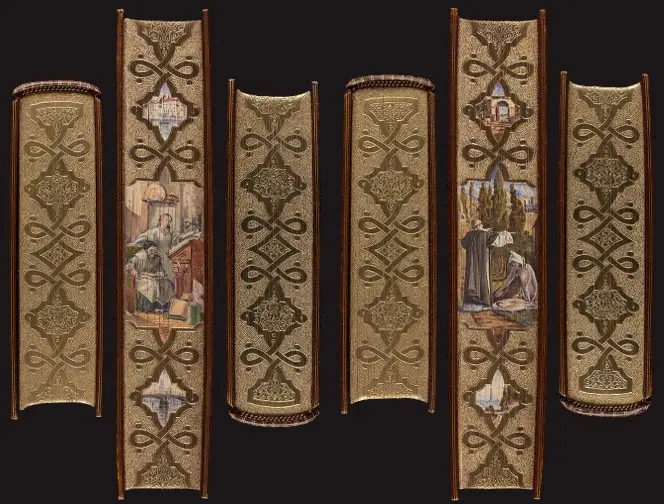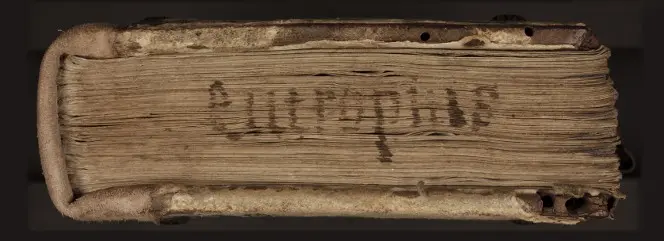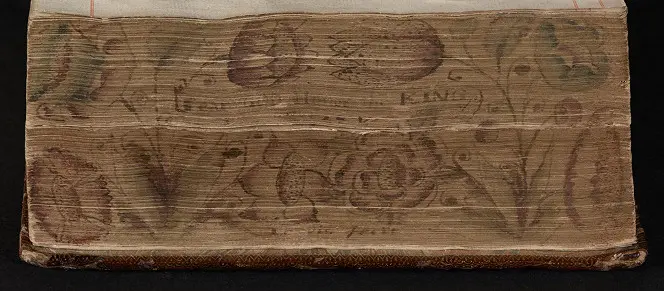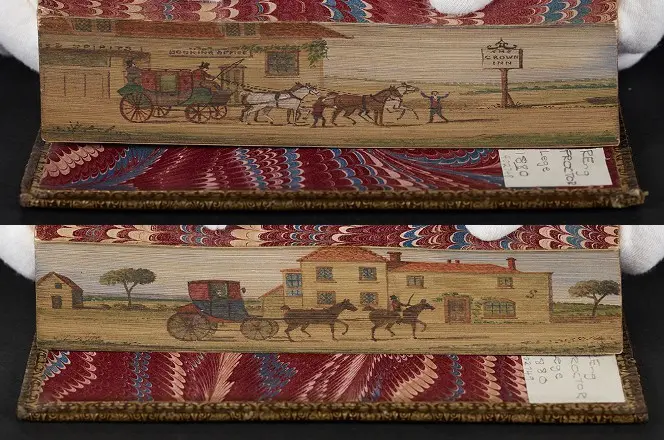A fascinating art
Let no edge remain undecorated
The Alexander Turnbull Library recently acquired a binding by Fazakerley of Liverpool. This firm, founded by Thomas Fazakerley in 1835 and continuing under his son John until the onset of World War One, was known for its fine bindings and fore-edge paintings.

Newly-acquired fore-edge paintings with gilded and gauffered edges by Fazakerley of Liverpool on the two volumes of Eliot, Romola, 1880. Ref: REng ELIOT Romo 1880.
The detailed watercolour miniatures delicately added to the beautifully gilded and gauffered (decorated) edges of the pages of this two-volume work provided the catalyst for highlighting other fore-edge paintings held by the Turnbull Library.
A world hidden under gold
The fore-edges of a book are the page edges opposite the spine, and these can be decorated in many different ways. Early books often had their titles or authors handwritten on their text edges rather than on the spine or cover, because they were usually stored with one of their edges facing out.

Author written on the lower text edges of a fifteenth-century manuscript, Eutropius, Historia Romana. Ref: MSR-08.
Over the centuries, edge decoration has included solid and sprinkled colour, marbled, paste, and gilded edges. The term ‘fore-edge painting’, however, usually refers to pictorial images such as coats of arms, scrolls, floral designs, or a detailed landscape scene or portrait.
Fazakerly fore-edge paintings are most often of the ‘closed book’ variety seen in the first image above, but these works of art can also be completely hidden under a layer of gold, miraculously appearing only when the pages are fanned out.
Embedded content: https://youtu.be/yiolBugEX-0
The painting of a pictorial scene or portrait on the leaf edges of a book, in particular the concealed painting, is believed to have been first practised in England around 1650 and became popular in the late eighteenth and early nineteenth centuries. There are several examples of this art in the Turnbull Rare Book Collection dating from the mid-seventeenth to the twenty-first century. The earliest, and perhaps the most significant, is a signed painting by the binders Stephen and Thomas Lewis who flourished in London in the 1650s.

Seventeenth-century fore-edge painting by Stephen and Thomas Lewis. The calf binding is decorated with a ‘cottage roof’ design, a style which began to appear from the mid-17th century. Reliquiae sacrae Carolinae, Hague i.e. London,1658.
Ref: REng CHAR Reli 1658.
One of only ten known examples of their work in the world, the Turnbull copy was identified in 1991 by Moira Long, a former staff member at the Turnbull Library. The book, Reliquiae sacrae Carolinae (1658), has a painting of a floral design with the motto ‘Fear God Honor the King’ and is signed ‘Lewis fecit’. The calf binding is also contemporary and was probably executed by the Lewis brothers at the same time.
Fazakerley of Liverpool
The Fazakerley fore-edge paintings on George Eliot’s two-volume set Romola (London: Smith, Elder, and Co., 1880), is late nineteenth-century in origin. Dating these artistic works is not always straightforward. Sometimes they are part of the binder’s art of decorating the book as here, but sometimes they are added later; thus the imprint date of a book is not necessarily the date when the fore-edge painting was created.
In addition fore-edge paintings are usually unsigned, which compounds the dating problem; the nineteenth century in particular saw many fore-edge paintings added to earlier books, mainly to increase their value. The fact that the Fazakerley binding is signed and that the triptych of paintings and gilded strapwork on all the text edges are typical of the Fazakerley style makes dating and provenance somewhat easier.
Both volumes in this two-volume set feature a fore-edge painting consisting of a larger central painting with two smaller ones on either side. The paintings are directly related to the content of the novel, something that is not always the case: vol.1 shows Romola assisting her blind father in his study, and vol.2 has Romola kneeling before a monk.

The brown goatskin binding on Eliot, Romola (1880) includes elaborately decorated doublures. At the lower edge it is stamped in gold ‘Fazakerley Binder Liverpool’
Edwards of Halifax
Another fore-edge painting in the collection is possibly by the well-known binding firm Edwards of Halifax. The calf binding is decorated in Edwards’ typical Etruscan style, and the fore-edge painting is of an unidentified English country estate.
Edwards of Halifax was a bookselling and bookbinding firm established in Halifax, Yorkshire, by William Edwards c.1755 and continued in both London and Halifax under his sons into the early nineteenth century. This firm is considered to be the originator of the English landscape style of fore-edge painting.

Late eighteenth-century example from the collection possibly produced by the well-known binding firm, Edwards of Halifax. Milton’s Paradise Lost, London, 1799. Ref: qRStuart 404.
The nineteenth century sees two examples in the collection, in both cases the artist and binder are unknown. First, another Paradise Lost, as seen in the video above.

Nineteenth-century fore-edge painting of London. Artist and binder unknown. Milton, Paradise Lost, London, 1805. Ref:REng MIL 1667 Para 1805.
And the second on a two volume set of poetry by British poet, Adelaide Procter.

Nineteenth-century fore-edge paintings on a two volume work. Artist and binder unknown. Procter, Legends and Lyrics, London, 1880-1881.
Ref: REng PROC Lege 1880.
Keeping the tradition alive
The most modern fore-edge painting in the Rare Book Collection was created in 2010 by the English artist, Margaret J. Costa, for a special edition of Jeff Weber’s Annotated dictionary of fore-edge painting artists & binders. Twenty-five paintings by three different artists were commissioned for the special deluxe edition. The three artists, Margaret Allport (Costa), Clare Brooksbank, and Martin Frost, are considered among the finest fore-edge artists in the world today.
The Turnbull copy, acquired in 2012, has a fore-edge painting signed MC in the bottom right-hand corner and is a world map featuring the flora and fauna of the seven continents.

Twenty-first century fore-edge painting by Margaret J. Costa. Jeff Weber, Annotated dictionary of fore-edge painting artists & binders, Los Angeles, 2010. Ref: REng WEBER Anno 2010.
Interested in learning more?
The Boston Public Library has a number of resources on fore-edge paintings.
A collector’s primer to the wonders of fore-edge painting.
great post